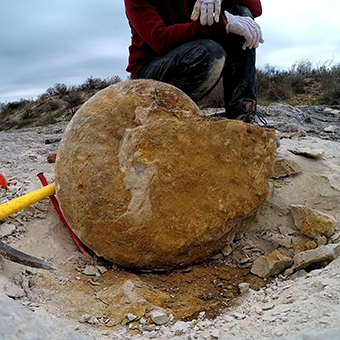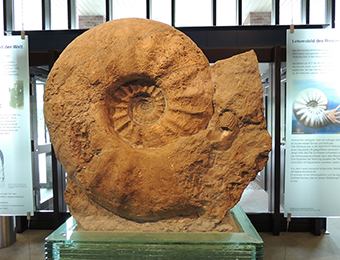Recent News on Giant Cretaceous Ammonites
Jura-Museum Eichstätt
Munich 11.11.2021
Parapuzosia seppenradensis, the largest ammonite in the world, measures up to 1.74 meters in diameter. Worldwide, there are only a few fossil findings of this already extinct cephalopod species from the Late Cretaceous (100-66 million years ago). In a new study, paleontologist and director of the Jura Museum in Eichstätt, Germany, Christina Ifrim, along with a team of researchers from the University of Heidelberg, the University of Portsmouth, and Mexican colleagues from the Museo del Desierto, Saltillo, Coahuila, examined and compared 154 specimens of the giant ammonite genus Parapuzosia from Europe and Mexico to find out more about their distribution and evolution. The scientists have now published the results of their investigations in the scientific journal PLOS ONE.
Ammonites are an extinct group of cephalopods and related to today’s squids. Giant forms of these animals, like Parapuzosia seppenradensis, inhabited the seas mainly in the Cretaceous (142-65 million years ago). At the end of the Cretaceous (66 million years ago), the ammonites became extinct together with the dinosaurs. The first specimen of the giant ammonite Parapuzosia seppenradensis was discovered in 1895 near Seppenrade in Westphalia. With a diameter of 1.74 meters, it is the world’s largest ammonite found to date – still.
Fossil findings of Parapuzosia seppenradensis have been extremely rare, so little is known about its evolutionary history. Paleontologists at Heidelberg University have now examined historical fossils and 102 new finds of the species from England and Mexico as part of a comprehensive comparative study. The team of scientists led by PD Dr. Christina Ifrim, now director of the Jura Museum in Eichstätt, Germany, compared a total of 154 Parapuzosia specimens that inhabited the Atlantic Ocean of the Upper Cretaceous 85-80 million years ago. 110 of them were found directly in the field in Mexico and England – a stroke of luck, as the chronological sequence was now able to be reconstructed. The researchers analyzed and correlated the exact shell dimensions of the fossils, their growth stages and the geographical distribution of their occurrences over time.
The analyses show that the earliest forms of Parapuzosia seppenradensis already lived on both sides of the Atlantic – in Europe and Central America – 83 million years ago. Their ancestors (Parapuzosia leptophylla), on the other hand, were initially native only to the European side and only later also to the Gulf of Mexico. In the course of the evolution of P. seppenradensis the paleontologists were able to detect a significant increase in the size of the shell from one to 1.8 meters. Cephalopods all became increasingly larger at this time, but none as large as Parapuzosia.
The researchers see a possible connection here with the simultaneous increase in size of mosasaurs, which were at the top of the food chain in the Cretaceous seas. The paleontologists were surprised by the distribution of fossils within their sites: Often, shells of exclusively adult animals were found concentrated in very narrowly defined areas. Nearby areas of the same locality, on the other hand, often did not yield any remains of P. seppenradensis. “This could be an indication of a so-called monocyclic reproductive strategy. In this strategy, an organism reproduces sexually only once in its lifetime before it dies,” says Christina Ifrim, lead author of the study, interpreting her observation.

Paleontologists recover a new giant ammonite in the field for the comparative study.
(Photo: Christina Ifrim, Jura-Museum Eichstätt)
New discovery of a giant ammonite from Mexico. (Photo: Nils Schorndorf) 
The largest ammonite in the world: Parapuzosia seppenradensis from Seppenrade in Westphalia (diameter: 1.74 meters). The fossil is on display at the Münster Museum of Natural History. (Photo: Christina Ifrim, Jura-Museum Eichstätt)
Publication:
Ifrim C, Stinnesbeck W, González González AH, Schorndorf N, Gale AS (2021) Ontogeny, evolution and palaeogeographic distribution of the world’s largest ammonite Parapuzosia (P.) seppenradensis (Landois, 1895). PLOS ONE 16(11): e0258510.
https://doi.org/10.1371/journal.pone.0258510
Contact:
PD Dr. Christina Ifrim
Jura-Museum Eichstätt
Tel.: 08421 602980 oder 0162 30 67 16
E-Mail: ifrim@snsb.de
Photos:
The images are available exclusively for editorial reporting on the subject of this press release.
About Us:
The Bavarian Natural History Collections (SNSB) are a non-university research and educational institution with six state natural history collections in the fields of zoology, botany, geology and paleontology, mineralogy, anthropology and paleoanatomy, as well as eight museums in Munich, Bamberg, Bayreuth, Eichstätt and Nördlingen and the Munich-Nymphenburg Botanical Garden, with a total of around 300 employees and over 31 million individual objects. The SNSB’s museums attract around 700,000 visitors annually.
The Jura Museum in Eichstätt displays in particular fossils from the Solnhofen plate limestones, which were unearthed in the quarries of the region. The impressive fossils from the Jurassic period 150 million years ago include the Eichstätt specimen of the famous prehistoric bird Archaeopteryx and the world’s only specimen of the predatory dinosaur Juravenator. The museum is run by the Catholic University of Eichstätt-Ingolstadt Foundation.
The largest part of the collection is owned by the Episcopal Seminary of St. Willibald in Eichstätt. The collection is scientifically supervised by the Bavarian Natural History Collections.



